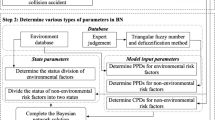Abstract
This paper introduces a model to estimate the consequences and related risk resulting from a collision between a LNG tanker and a tug during harbour entrance manoeuvres, The analysis is carried out for Zeebrugge harbour, where very dense traffic, including LNG tankers, is observed. The conditional probability that the collision seriously damages the LNG tanker during the mooring operations is estimated by means of a Bayesian Belief Network (B5N). Furthermore, the events that lead to a collision are identified as well as the prior probabilities of each event are evaluated in the course of numerical simulations, observations and a literature survey. The consequences of the collision are related to the costs of LNG tanker repair and the risk, expressed in monetary terms, is determined on the annual basis.
Similar content being viewed by others
References
ANTÃO P. Guedes Soares C. (2006). “Fault-tree models of accident scenarios of RoPax vessels.” International Journal of Automation and Computing 3, no. 2, pp. 107–116.
Chan, H., Darwiche A. (2002). “When do numbers really matter?” Journal of artificial intelligence research 17, pp. 265–287.
Chen H., Moan T. (2004). “Probabilistic modeling and evaluation of collision between shuttle tanker and FPSO in tandem offloading.” Reliability Engineering & System Safety 84, no. 2, pp. 169–186
Chen H., Moan T., Haver S., Larsen K. (2004). “Prediction of relative motion and probability of contact between FPSO and shuttle tanker in tandem offloading operation.” Journal of Offshore Mechanics and Arctic Engineering, 126, pp.235–242.
Claes L, and Guillaume-Combecave J.-L (2009). “An innovative LNG Carrier.” In Zanic V, and Andric J. (editors) Proceedings of IMPROVE final workshop. Zagreb, pp. 87–89.
Ehlers S. (2010). “The influence of the material relation on the accuracy of collision simulations.” Marine Structures, 23(4), pp. 462–474
Ehlers, S., Broekhuijsen, J., Alsos H. S., Biehl, F., Tabri, K. (2008). “Simulating the collision response of ship side structures: A failure criteria benchmark study.” International Shipbuilding Progress 55, pp. 127–144.
Ehlers, S., Klanac, A., Kõrgesaar, M. (2008). “A design procedure for structures against impact loading.” STG Yearbook.
Eleye-Datubo A. G., Wall A., Saajedi A., Wang J. (2006). “Enabling a Powerful Marine and Offshore Decision Support Solution Through Bayesian Network Technique.” Risk Analysis, 26,3, pp. 695–721.
Eleye-Datubo A. G., Wall A., Wang J. (2008). “Marine and offshore safety assessment by incorporative risk modeling in a fuzzy-bayesian network of an induced mass assignment paradigm.” Risk Analysis, 28,1, pp. 95–111.11.
Eunchang L., Yongtae P., Jong Gye S. (2009). “Large engineering project risk management using a Bayesian belief network.” Expert Systems with Applications, 36, pp. 5880–5887.
Friis-Hansen A. (2000). “Bayesian Networks as a decision support tool in marine application.” PhD Thesis, DTU, Lyngby.
Hallquist, J.O. (2007). LS-DYNA. “Keyword User’s Manual, Version 971.” Livermore: Livermore Software Technology Corporation.
Hugin Experts A/S (2010). “HUGIN API reference manual. Version 7.4”, available online: https://doi.org/download.hugm.com/webdocs/manuals/api-manual.pdf
Jensen F.V., Nielsen T.D. (2007). “Bayesian networks and decision graphs.” Springer.
Kaplan S. (1997). “The words of risk analysis.” Risk analysis, 17(4), pp. 407–417.
Kiriya N. (2000). “Statistical study on reliability of ship equipment and safety management — reliability estimation for failures on main engine system by ship reliability database system.” Bulletin of the JIME, 29(2), pp. 64–70.
Konsberg Marine (2009). “Description of Ship Model TUG06 Single Screw 4000 HP T.S.” Harbour Tug Java Victor I Full Load Version 4.
Kristiansen S. (2004). “Maritime Transportation: Safety Management and Risk Analysis.” Butterworth-Heinemann.
Madsen, A., M. Lang, U. Kjrul, and F. Jensen (2003). “The Hugin tool for learning Bayesian Networks.” In T. Nielsen and N. Zhang (Eds.), ECSQARU 2003, LNAI 2711, pp. 594–605. Springer-Verlag Berlin Heidelberg.
Pedersen, P.T. (2002). “Collision risk for fixed offshore structures close to high-density shipping lanes.” Proc Insitution of Mechanical Engineers, Part M: Journal of Engineering for the Maritime Environment 216,no. 1(1): pp. 29–44.
Pill I., Tabri K. (2009). “Finite element simulations of ship collisions: A coupled approach to external dynamics and inner mechanics.” In proceedings of Analysis and Design of Marine Structures, pp. 103–109.
Ren J., Jenkinson I., Wang J., Xu D.L., Yang J.B. (2009). “An Offshore Risk Analysis Method Using Fuzzy Bayesian Network.” Journal of Offshore Mechanics and Arctic Engineering 131,no. 4, pp 041101-1–12
Romanoff et al. (2007). “Catalogue of the Selected Methods to Solve the Structural, Production and Operation Issues Affecting Design of 3 Application Cases.” EU IMPROVE Deliverable 2.6.
Sandom C., Harvey R.S. Institution of Electrical Engineers (2004). “Human factors for engineers. IET.”
Tabri K, (2010). “Dynamics of Ship Collisions. Doctoral dissertation.” Aalto University.
Uusitalo, L. (2007). “Advantages and challenges of Bayesian networks in environmental modelling.” Ecological Modelling, 203,(3/4), pp. 312–318.
Vanem E., Antão P., Østvik I., Del Castillo de Comas F. (2008). “Analysing the risk of LNG carrier operations.” Reliability Engineering & System Safety 93, no. 9, pp. 1328–1344.
Vinnem J. (2007). “Offshore Risk Assessment.” 2nd ed. Springer, London.
Weber, P. Medina-Oliva G., Simon C., Iung B. (2010). “Overview on Bayesian networks applications for dependability, risk analysis and maintenance areas.” Engineering Applications of Artificial Intelligence, doi:10.1016/j.engappai.2010.06.002
Zhang, L., Egge, E. D., Bruhms, H. (2004). “Approval procedure concept for alternative arrangements.” In Proceedings of the Third International Conference on the Collision and Grounding of Ships, Izu, Japan, pp.87–97.
Zolotukhin A.B., Gudmestad O.T. (2000). “Use of Fuzzy Sets Theory in Qualitative and Quantitative Risk Assessment.” Proc SPE International Conference on Health, Safety and Environment in Oil and Gas Exploration and Production, Stavanger.
Author information
Authors and Affiliations
Corresponding author
Rights and permissions
About this article
Cite this article
Montewka, J., Ehlers, S. & Tabri, K. Modelling risk of a collision between a LNG tanker and a harbour tug. Mar. Syst. Ocean Technol. 7, 3–13 (2012). https://doi.org/10.1007/BF03449259
Received:
Accepted:
Published:
Issue Date:
DOI: https://doi.org/10.1007/BF03449259




